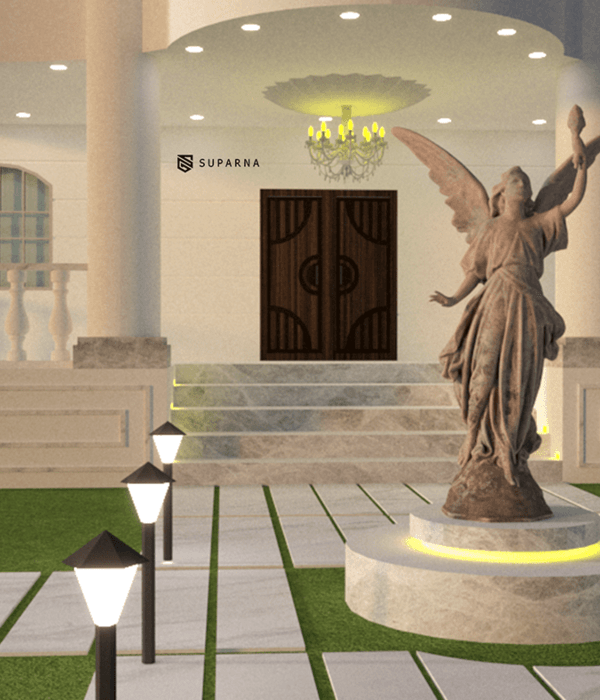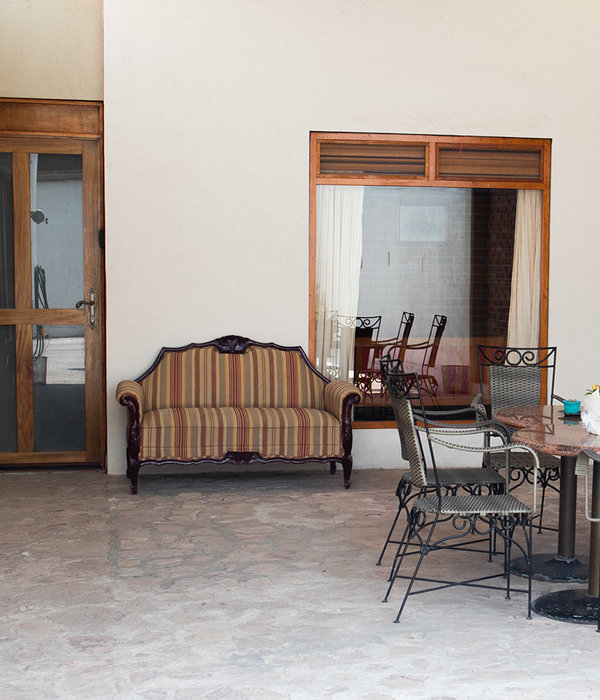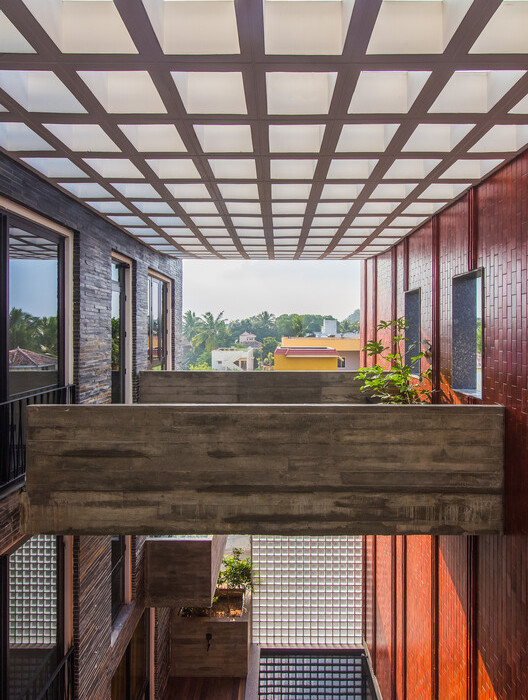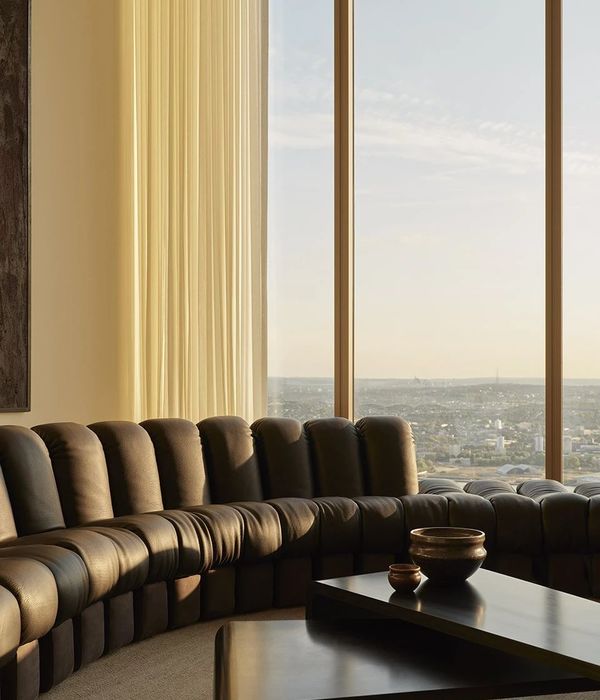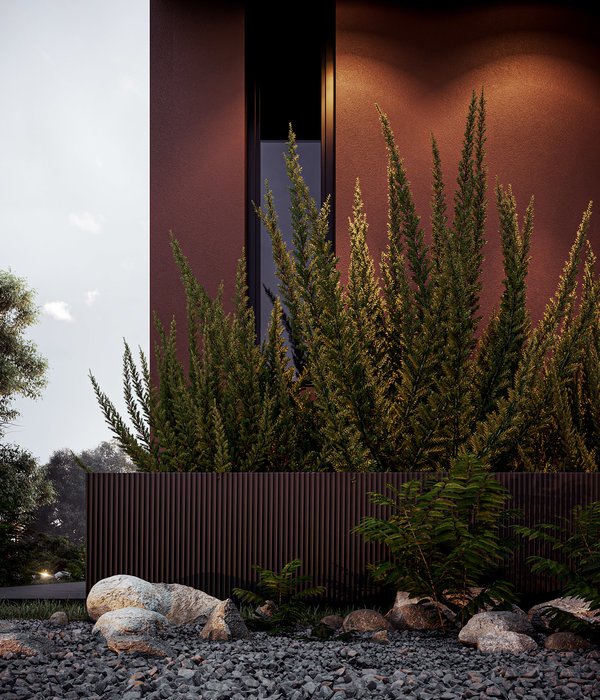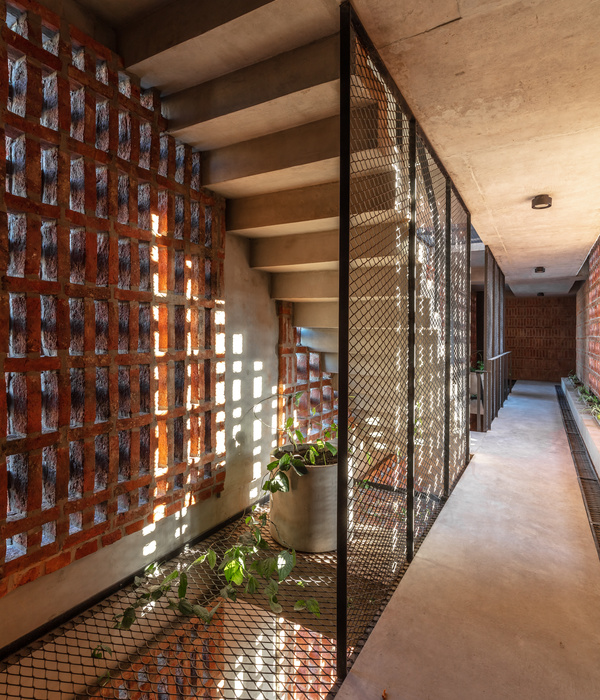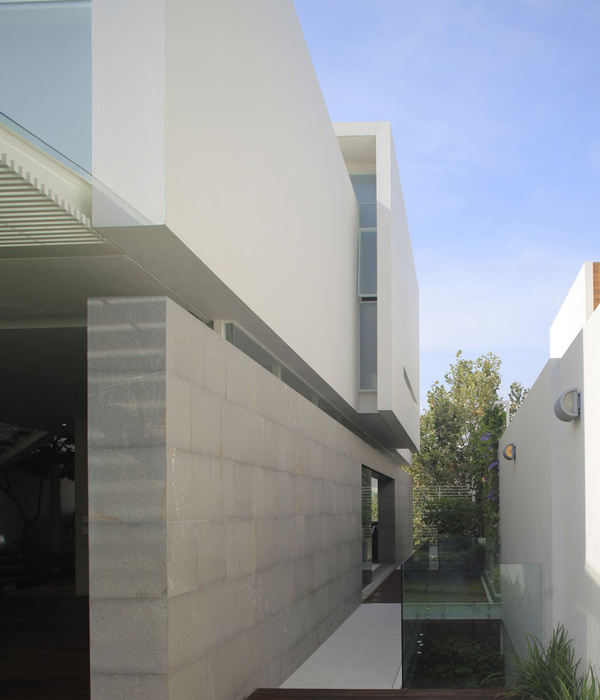- 项目名称:《七重花园》办公楼改造
- 设计团队:全体建筑
- 设计主创:刘琮晓,刘潇
- 施工团队:业主组建施工团队
“七重花园”是一个位于佛山的改造项目。原建筑是一座改革开放初期落成的宾馆,坐落在佛山高明区(原高明市)主干道。原建筑楼高7层,白色瓷砖,黄色琉璃瓦,顶层点缀了一个中式八角亭。在城市当时尚属平坦的天际线中,无疑是最受瞩目的建筑之一。后来,这座宾馆被改造为一间夜总会,客房变成了卡拉OK和洗浴包间。为了增加营业面积,在建筑西侧增加了一排房间,交通从外廊转变成了内廊式。开敞阳台也被封闭,更换了当时比较流行的镀膜玻璃。在经历了一段时间的繁荣之后,好景不长,夜总会的生意最终也没落下来。
Layered Garden is an office renovation project in Foshan city. The original structure was a hotel constructed in the early 80’s. The building has 7 floors, covered with glazed tiles, and decorated with a Chinese kiosk on the roof. Soon afterwards its construction, the hotel was transformed into a Night club (bath center). The building volume was expanded eastwards to increase more room units, turning the outdoor corridor into a closed one. The balconies were also shut down by glazed glass curtains.
▼项目鸟瞰,aerial view of the project © 黄东华
▼项目外观,external view of the project © 黄东华
▼近景,closer view © 黄东华
第一次参观场地时,建筑已经被废弃多年了。立面的出挑阳台给我们留下了很深印象,这是一种八十年代建筑立面常见的处理方式。但如今阳台已经被镀膜玻璃所覆盖,难以辨识出最初的形态。在拆除镀膜玻璃后,我们惊喜地发现挑板全部保存完好,而且悬挑做的非常轻薄。
When we visited the site, the building had already been abandoned for years. The only few things that impressed us were the toothed-shape balconies on the façade. They were no longer visible because of the cover of glazed glass curtains.
▼改造前,photos before renovation © 黄东华
设计决定保留这些梯形挑板,在上承托同一规格的弧形穿孔板。弧形,除了有视觉形象的考虑之外,更多是出于构件受力的需要:弧形轮廓可以保证受力均匀,不需要多余的加强,仅仅通过上下挑板之间几个角件就可以实现自受力,且不易变形。每片挑板安装3块穿孔板,采用正弧/反弧交错拼接成立面。设计还决定拆除原有建筑的琉璃瓦和瓷砖,统一更换为白色涂料,希望一种经济的方式呈现出单纯,明快的建筑形象。
▼穿孔板构造,composition of the perforated panel © 全体建筑
We decided to remove the glass and exposed the structure. These are cantilevered structural plates, preserved well after the removal of the glass curtains. We tried to preserve these structures, and transformed them into the new façade carrying perforated metal panels. These panels were fabricated in curve profiles, all in the same size. Each of the structural plate supports 3 panels. With concave and convex arrangements, they compose the façade in a rhythmic expression. We also decided to demolish the glazed tiles and replaced by simple white paint. All the design moves were trying to create a clear and clean appearance of the building.
▼纯白立面,white facade © 黄东华
▼梯形挑板上承托弧形穿孔板,the cantilevered structural plates support the perforated metal panels © 黄东华
▼正弧/反弧交错拼接成立面,concave and convex arrangements compose the façade © 黄东华
▼透过弧形穿孔板望向室外,view to the outside through the perforated panels in curve profiles © 黄东华
除了立面以外,改造更多是在底层的物理环境话题中进行,通过采光、通风、交通一系列措施来满足办公空间的需求。所面临的限制条件是:在不同年代,建筑已经经历了多次加建,除了主体结构基本无法变动之外,不同区域也面临不同的结构限制。另外,改造的投入也十分有限,设计动作要尽可能小。
Apart from the appearances, the renovation took place from bottom up. The qualities of spaces were improved through optimizations on physical environments, such as light, ventilation and circulations. The restrictions for the renovation were also clear: The structure frameworks were difficult to change, and the investments were quite limited.
▼门厅,lobby © 黄东华
设计面临的核心矛盾是如何提升空间物理条件的问题。原建筑为内廊式交通,如今周边环境被住宅楼遮挡,采光和通风早已无法满足最基本的办公空间需求。考虑到原建筑平面为L形,显然,采光和通风最不利的位置为L形平面内转角,这个区域虽然不适合布置功能用房,但可以用作空间枢纽衔接各个空间。在经过各方评估之后,设计尝试把原来沿街的楼梯和电梯等垂直交通置换到此处,改造为绿化的中庭。一方面,让更多的光线进入到空间内部;另一方面,也一并将沿街最有商业价值的空间较为完整地释放出来。
The design focused on how to improve the physical environments. The existing space conditions had no longer satisfied the needs of an office space. Considering the building plan is L shape, the inner corner of the L is the most disadvantageous in terms of lighting and ventilation, but suitable for circulations. We shifted the elevators and stairs here, turning the space into an atrium. It works as a light well. More lights can penetrate the building, and more spaces along the street are able to be released.
▼中庭-通高空间,atrium-height space © 黄东华
中庭共六层,采用错层通高方式布局,两层一个单元叠合形成垂直空间。中庭,一方面是垂直方向上的枢纽,同时也是办公人员休憩交流的空间。设计同时决定拆除位于内廊,不作承重之用的实墙,改为玻璃。中庭的打通,内廊的穿透,让室内物理条件得到了较大程度的改善。遗憾的是,在室内深化阶段,业主聘用了第三方设计团队进行了二次装修。目前的中庭是二次装修后的结果。
The atrium has 6-storey height, composed of double height space every two floors. The space takes a double role, both as a vertical core and leisure space. We also demolished the interior walls to invite more lights and air into the building. Through multi-dimensional interventions, the space qualities have been greatly improved.
▼中庭-休憩空间,atrium-leisure space © 黄东华
在最初的提案中,我们还建议将顶层设置为共享休闲空间。利用钢结构创造局部通高,灵活隔断,让中庭一直延续至屋顶,成为垂直花园的延续,在这里可以远眺东江的景观。但随着工作不断深入,我们发现面临的阻力远比想象中大。业主最终决定屋顶全部采用平层,全部作为办公空间租出。关于顶层公共性的设想只能停留在纸面。
In the original proposal, we suggested to transform the roof into an observation deck. The space was set as an open, double height, with views toward the nearby river. Unfortunately, the idea was not adopted due to the city regulation and budget cut. the space was divided into office units and leased. The imagination of its publicity can only exist on paper.
▼顶层办公区,office area on the top floor © 黄东华
项目在2019年底开工,2020年由于疫情原因暂停,年中复工,年底完成,如今已有一些机构陆续入住。从最终的效果来看,设计并没有得到完整地执行。如,出于节省造价的考虑,中庭空间内外的穿孔板幕墙被取消;一些公共空间的空间也被划分为办公室;楼宇内部进行了二次装修,加装了一台电梯,导致中庭被迫缩小。总体而言,最终实现效果与最初设想显然有一段距离。仅存的是改造初期设立的几个基本目标,如沿街立面的穿孔板效果,中庭的位置和基本形态,外观和室内品质等等,得到了一定程度提升。
The construction started from late 2019, postponed in the pandemic, and finished in early 2021. As the result reveals, the original design has not been fully executed. The reduction of budget and changing of programs, forced the metal panel in the atrium all been cancelled, and the atrium reduced its size. The resulting quality is regretfully far from our expectation. But there are a few principles been kept: The façade appearance, the space of atrium and the improved of lighting and ventilation qualities, etc.
▼中庭穿孔板幕墙细部,details of perforated panel curtain wall in the atrium © 黄东华
这是一个遗憾和收获并存的项目,我们越来越深刻地意识到,建筑学是一门美学、工程学,同时也是一门社会学和经济学。项目的落地需要多个因素的共同参与,建筑师除了本身的“设计者”角色之外,还应当努力转变为一个“沟通者”和“组织者”,除了设计层面的表达和输出之外,更重要的作为中介和桥梁,让每个利益者的观念都能够发出自己的声音,并让大家都能参与到一个共同创造的想象中来。在成长之路上,这是需要建筑师反复练习,并不断自省的过程。
We are getting more aware of the fact that architecture is a balance of aesthetics, engineering, and economics. The realization of a project requires the involvement of multiple dimensions. Architects should take the roles not only as creators, but more as communicators and organizers. To fully achieve design goals, it is crucial for architects to prepare a platform, to welcome stakeholders to have their voices, and let everyone to get involved in the collective visions.
▼轴测图,axon drawing © 全体建筑
▼一层平面图,1F plan © 全体建筑
▼二层平面图,2F plan © 全体建筑
▼三层平面图,3F plan © 全体建筑
▼七层平面图,7F plan © 全体建筑
▼立面图,elevations © 全体建筑
▼剖面图,section © 全体建筑
项目:佛山七重花园 功能:办公楼改造 建筑设计:全体建筑 室内设计:业主团队 设计主创:刘琮晓,刘潇 设计团队:黄东华,杜冠之,詹潇宇,薛妍 施工团队:业主组建施工团队 设计时间:2018-2020
Project: Layered Garden, Foshan Program: Office Renovation Architectural Design: Atelier ALL Interior design:Client Designers in-chief: Congxiao Liu, Xiao Liu Team: Donghua Huang, Guanzhi Du, Xiaoyu Zhan, Yan Xue Construction: Constrution team grouped by the client Period: 2018-2020
{{item.text_origin}}


